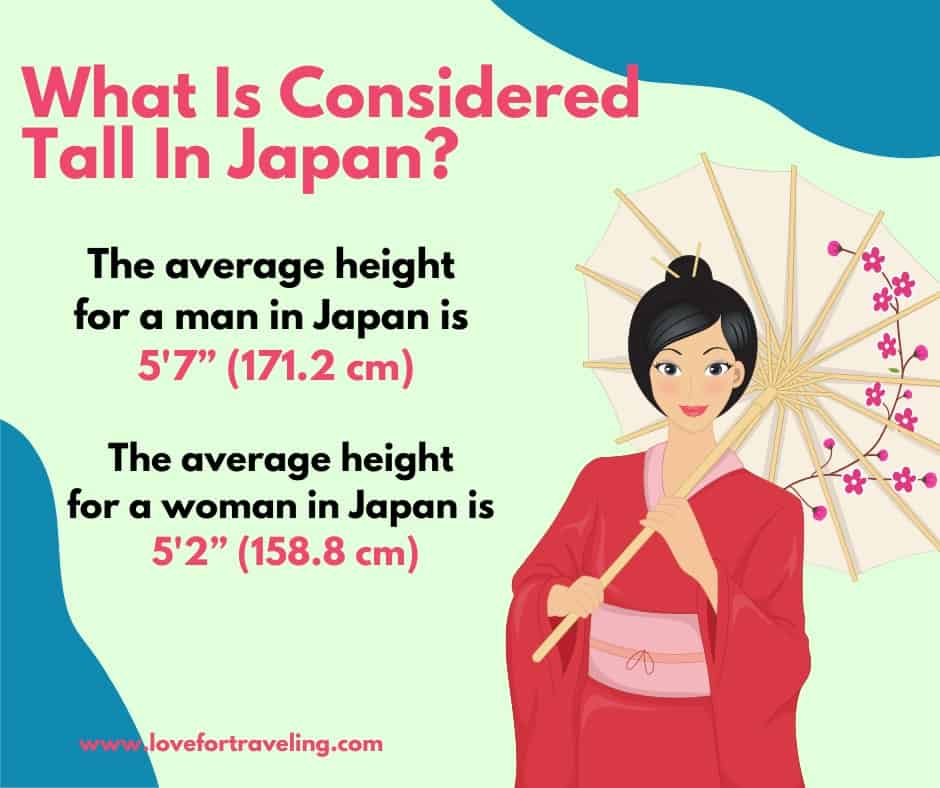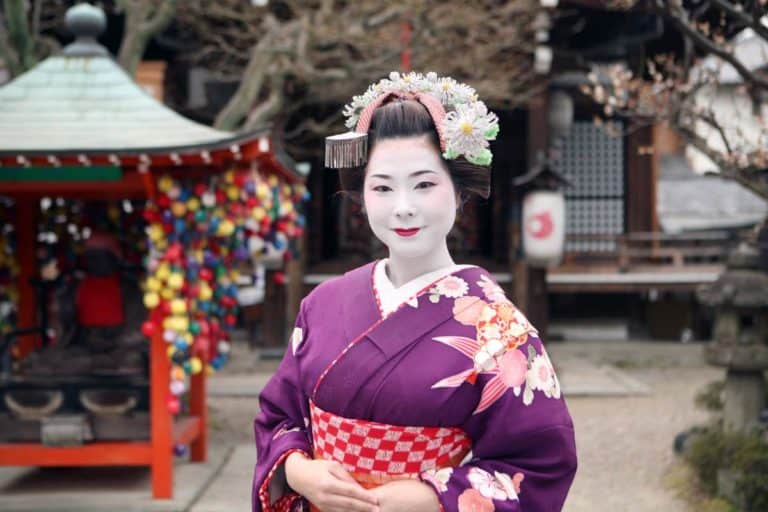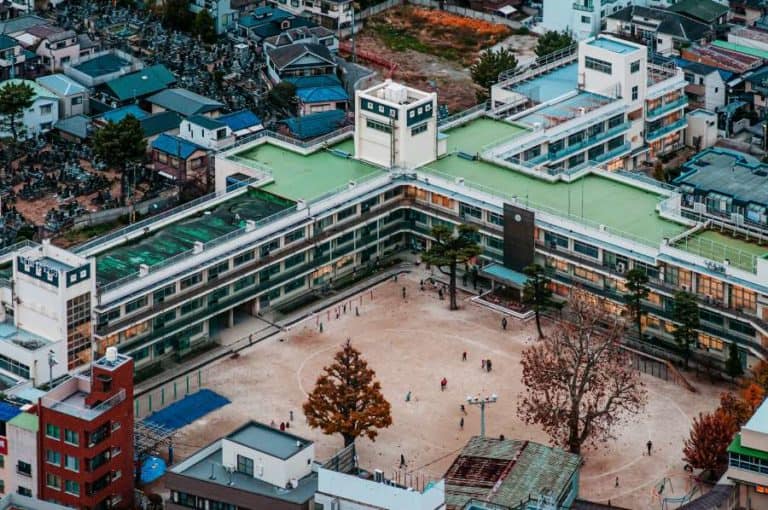What Is Considered Tall In Japan?
The stereotype that Japanese people are “short” compared to the rest of the world is no longer valid today.
However, due to their historically shorter stature, there are still average heights that you may surpass. So, what height is considered tall in Japan?
Suppose you are above 6 ft 2 inches (190 cm) for a male and 5 ft 7 inches (175 cm) for a female. In that case, you will be considered exceptionally tall in Japan as you surpass their average height of 5 ft 10 inches (171.2 cm) for a male and 5 ft 2 inches (158.8 cm) for a female by a large margin.
The world perception of the height of Asian people, in general, is that they are shorter than other populations, but this is more perception than reality.
The average height of Japanese people has changed in a short time.
What is the history behind the Japanese people’s height, and why has it changed so much over the years?
What are the difficulties of being tall in Japan? We go through these questions and others in this article.
Average Height in Japan VS USA
| Average Japanese Male Height | 5’7” | 171.2 cm |
| Average Japanese Female Height | 5’2” | 158.8 cm |
| Average Male Height in the U.S | 5’10” | 178.2 cm |
| Average Female Height in the U.S | 5’4” | 164.1 cm |
What Height Is Considered Tall In Japan?
Japan has long been considered a “short” population worldwide, but this is not the case.
Japan’s population is, on average, a good height, and they are actually on par now with most other countries in the world in terms of average height.
The average height for a man in Japan is 5 ft 7.4 inches (171.2 cm) which is not that short and is similar to the average male’s height in America which is 5 ft 10.2 inches (178.2 cm).
The average height for a woman in Japan is 5 ft 2.6 inches (158.8 cm) which is also similar to the average female’s height in the U.S., which is 5 ft 4.6 inches (164.1 cm).
So, as you can see, the average height of Japanese people can not be considered short compared to the rest of the world. But these are only the averages; people can be shorter or even taller than these averages.
For example, in the 1600s, Akashi Shiganosuke was a sumo wrestler formally recognized as the first yokozuna.
He was described as gigantic, standing 8 ft 6 inches (258 cm) tall.
Of course, the dramatic height of Akashi is more an exception than the rule, and people of his stature in Japan are not common.
However, no such giants are living in Japan today, so if you are visiting Japan and you are taller than these average heights, then you may be considered tall in the country, but if you are over the height of 6 ft 2 inches (190 cm) for a male and 5 ft 7 inches (175 cm) for a female, then you will most likely be considered exceptionally tall in Japan.
The History Of Peoples Height In Japan

Japanese people were considered relatively short in history books and even up to a few decades ago, but this is no longer true in our modern world.
After the Second World War, the rapid westernization of traditional Asian countries such as Japan brought about significant changes, not only to their society but also to their people, including their stature. (See also our article about height in the Philippines.)
The changes that the Japanese people have experienced in their diets and lifestyle due to their country’s westernization have led to Japanese people showing one of the fastest collective growth spurts to have ever been recorded in modern society’s history.
In the past 30 years, the average height of the Japanese male has increased by nearly 4 inches, with the average Japanese female’s height increasing by 2.7 inches.
Public health experts cite several reasons why this massive change is happening in the stature of an entire nation. But the main fundamental change is the change in the Japanese diet, which is quite visible in their everyday lives.
For example, Japanese people are now turning away from their traditional lunches of rice balls wrapped up in seaweed and are instead lining up outside places like KFC and McDonald’s, which have currently ranked as their number one and two most popular restaurants in the country.
The most significant change in the diet of Japanese people has been the decline of grains, particularly rice, and the sharp increase of high-caloric animal foods being eaten, with meat and dairy consumption increasing at a surprising rate.
The combination of a higher calorie diet and a trend towards more office-type employment rather than subsistence farming has contributed to the general increase in the population’s average height.
These changes to the Japanese diet and lifestyle are not the only contributing factors to people being taller and more prominent over the years.
According to the Japanese Health Ministry, another factor could be considered a contributing factor to this height change.
This surprising factor is that many Japanese people nowadays commonly sit and work in Western-style chairs both at home and at work, instead of sitting the traditional way of kneeling on a rice-straw mat as the Japanese did for centuries.
According to the Japanese Health Ministry, this has stopped the constant pressure on young Japanese children’s knees, leading to the children growing up taller than previous generations.
But whatever the reason for this rapid growth spurt of the Japanese population, you can be sure that they will most likely keep growing past their average height today.
So, you may be considered tall in Japan now, but it may go a different way in the future.
The Difficulties Of Being Tall In Japan

If you are tall and want to visit Japan, then there may be some obstacles that you will face due to your height, as Japan does not cater to exceptionally tall people.
Some challenges you may face include finding a bed you can fit in.
The beds in hotels and other accommodations may be too short for you; in this case, you may opt for sleeping on a futon as they generally have extra futons that you can put together so you can fit comfortably on them while you sleep.
Another difficulty for tall people in Japan is the height of the doorways.
Japanese homes are not generally built with high doorways as they are not needed, but if you are taller than the average in the country, you will probably need to duck through every doorway you go through, which can be a pain on your back or neck.
Something else to consider is when you go to restaurants in Japan, the space under the tables tends to be relatively small, so if you have long legs, you may struggle sitting in a restaurant.
If you are exceptionally tall and want to go to Japan, you may have to put up with some Japanese people staring at you as you will be an unusual sight to them.
But you will find that you get used to this quite quickly.
Apart from these few things, you should have no issues with visiting Japan if you are considered tall.
Your height may even give you an advantage in making new friends as the people will find you fascinating.
Conclusion
Japanese people are not as short as once; you might fit in height-wise when you visit Japan.
You might only be considered exceptionally tall if you are taller than 6 ft, and you may have some trouble with space in certain aspects of Japan, but you will certainly still enjoy your visit!






